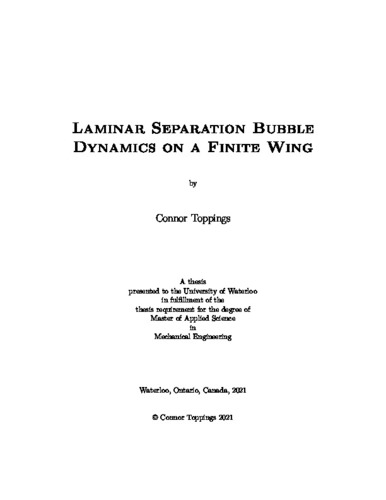| dc.contributor.author | Toppings, Connor | |
| dc.date.accessioned | 2021-07-30 15:56:43 (GMT) | |
| dc.date.available | 2021-07-30 15:56:43 (GMT) | |
| dc.date.issued | 2021-07-30 | |
| dc.date.submitted | 2021-07-14 | |
| dc.identifier.uri | http://hdl.handle.net/10012/17177 | |
| dc.description.abstract | Laminar separation bubbles substantially influence the performance of finite wings at low
chord Reynolds numbers. The objective of this study is to explore the influence of wingtip
effects on three-dimensional laminar separation bubble topology and dynamics on a finite
wing. An experimental investigation is conducted on a laminar separation bubble forming on
the suction surface of a cantilevered rectangular NACA 0018 wing with a semi-aspect ratio
of 2.5 at a chord Reynolds number of 125 000 and an angle of attack of 6 degrees. Surface pressure
and particle image velocimetry measurements are employed to investigate the separation
bubble flowfield. Using a two-dimensional airfoil of the same profile, the separation bubble
on the wing is compared to a nominally two-dimensional separation bubble at similar
effective angles of attack. On the portion of the wing where laminar boundary layer
separation occurs, the separated shear layer rolls up into spanwise uniform vortices which
develop similarly to the vortices observed on the two-dimensional airfoil, despite spanwise
changes to the mean separation bubble structure along the wingspan. Whereas a decrease in
the angle of attack of the two-dimensional airfoil causes a downstream shift in the locations
of separation and reattachment and a reduction in the frequency of shear layer vortex
shedding, spanwise variations of these parameters on the wing are much smaller than the
variations expected due to the reduction in effective angle of attack near the wingtip. On the
inboard portion of the wing, the location and vortex shedding frequency of the separation
bubble are analogous to the separation bubble on the two-dimensional airfoil at the effective
angle of attack of the wing root. Downwash from the wingtip vortex inhibits boundary layer
separation in proximity to the wingtip, suppressing shear layer vortex shedding and causing
a delay in transition near the wingtip. Unlike a canonical two-dimensional separation bubble,
the separation bubble on the wing becomes an open separation near the wingtip, where
the spanwise pressure gradient causes fluid to enter into the separation bubble, producing
a substantial spanwise flow within recirculation region. A comparison with the results of
previous studies suggests a similar bubble topology across different wing geometries and
experimental conditions. The results of this investigation quantify the influence of wingtip
effects on a laminar separation bubble, elucidating the three-dimensional changes to the
bubble’s mean structure and dynamics along the wingspan. | en |
| dc.language.iso | en | en |
| dc.publisher | University of Waterloo | en |
| dc.subject | aerodynamics | en |
| dc.subject | laminar separation bubble | en |
| dc.subject | boundary layer | en |
| dc.subject | turbulence | en |
| dc.subject | airfoil | en |
| dc.subject | wing | en |
| dc.title | Laminar Separation Bubble Dynamics on a Finite Wing | en |
| dc.type | Master Thesis | en |
| dc.pending | false | |
| uws-etd.degree.department | Mechanical and Mechatronics Engineering | en |
| uws-etd.degree.discipline | Mechanical Engineering | en |
| uws-etd.degree.grantor | University of Waterloo | en |
| uws-etd.degree | Master of Applied Science | en |
| uws-etd.embargo.terms | 0 | en |
| uws.contributor.advisor | Yarusevych, Serhiy | |
| uws.contributor.affiliation1 | Faculty of Engineering | en |
| uws.published.city | Waterloo | en |
| uws.published.country | Canada | en |
| uws.published.province | Ontario | en |
| uws.typeOfResource | Text | en |
| uws.peerReviewStatus | Unreviewed | en |
| uws.scholarLevel | Graduate | en |

